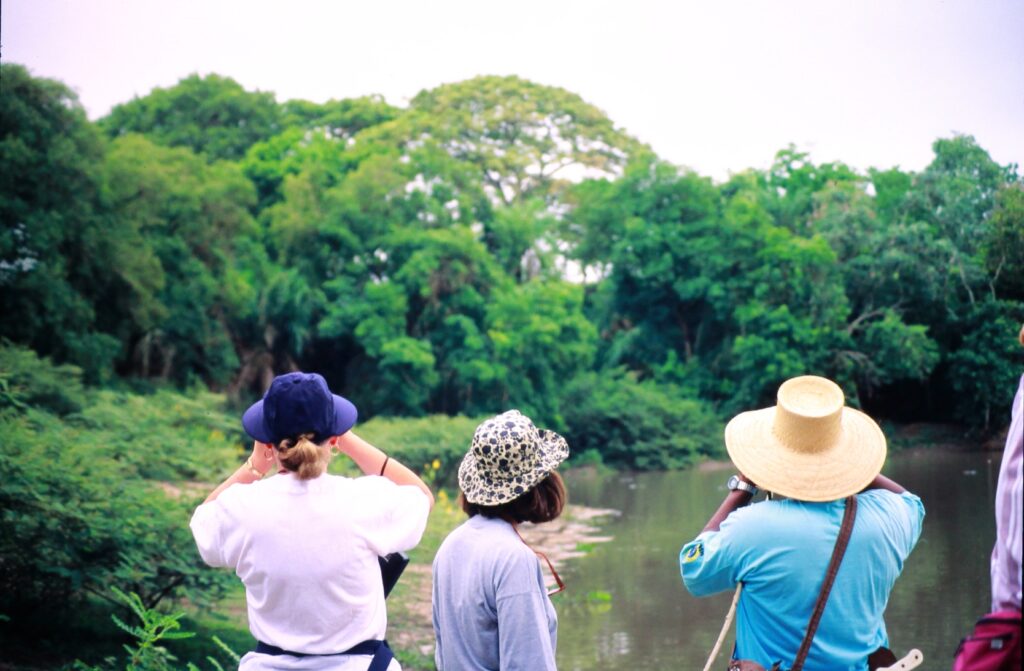
It had been the quiet wonders, from the pastel palette hues of Pelourinho in Salvador to the tasty seafood moquecas at Pedra do Guaratiba, that won me over in Brazil. Now as I approached the stilt-held Baiazinha Lodge on the shore of a lagoon in the interior of Brazil’s Mato Grosso do Sul, I marveled at the tree frogs, their boisterous burps soothing even amid the lightning bolts that flashed that night across the Pantanal.
After a two-hour flight from Rio to Campo Grande and a four-hour bus ride to Caiman Ecological Refuge, I finally stepped inside the lodge and found the rest of the group already sprawled about the cozy room. We had come to see the Pantanal (officially O Grande Pantanal), a vast swampland spanning some 250,000 square kilometres – 1/2 the size of the Yukon situated mostly in western Brazil but also in Bolivia and Paraguay.

Every year from November to March, rainfall descends from the surrounding highlands to flood the plains below. By January, the Pantanal is transformed into the largest freshwater swamp in the world, making it a major migratory pit stop for more than 600 species of birds. Long, thin chains of forests, only 40 cm higher than the grasslands, become islands of refuge for the land animals.
Besides being the last stronghold for the jaguar, the Pantanal is home to more than 100 animal species including deer, monkeys, tortoises, anacondas, armadillos, anteaters and, it seems, a million caimans, South American crocodilians.

The first morning in the Pantanal, we went for a walk. A three or four-day program at Caiman also includes horseback rides, boat trips, and night and day drives to spot wildlife. After Carla Marcello, our Brazilian English-speaking guide, told us to put bug repellent on and tuck our pants into our socks, we headed across the savannah.
It was never long before we’d see something exciting. In the cordilheira Queixadas forest section, a ringed-tailed coati – somewhat like a large raccoon-tumbled out of a tree and bolted into the forest. Howler monkeys swung high above us, screeching as we walked past. Black-billed Annies in a piuva tree sounded exactly like a pot of boiling water. Marsh deer and greater rheas bounded across the scrub lands.

Near a small caiman-infested pond, capybaras looked up from their grazing and scurried off into the high grasses. The world’s largest rodents, capybaras can grow as long as 1.2 metres and weigh up to 50 kilograms. They seem less like rats, however, than cute guinea pigs.
Flocks of monk parakeets fluttered past us in a green burst of chirps and whistles. Ibises, waders, coots and black-bellied whistling ducks lifted off from watering ponds. It’s possible to tire of seeing the plentiful snail kites, wood storks, herons and hawks, but it was always a thrill to glimpse a hyacinth macaw (some birders come just to see this endangered species) or toucan flapping past with its incredible orange beak. An even greater thrill was to see the red-necked jabiru stork, a bird that stands some 1.2 metres high and has a wingspan wider than a Mercedes.

We saw dozens of caimans. They look like small crocodiles (although they can grow as long as 2.5 metres), but act like alligators, which means they will probably not attack a passing leg.
You’ll also see plenty of cattle. The Caiman Ecological Refuge is actually a farm, one of many that have been in the Pantanal for more than 100 years. Brazil’s west-central region has long been considered the wild west from the days of the 17th century when pioneers ventured inland for slaves and precious stones. By the 19th century, families had started to graze cattle. When tourism to the Pantanal increased in the early ’90s, Piuva Lodge across the lagoon from the main Pousada Caiman was built. Then, in 1992, two eight-room “outpost” lodges, Baiazinha and Cordilheira, were added.

Each of those is a delightful one-level wood and brick structure built on cement posts over a lagoon or grassy plain. Common areas combine a cozy sitting area, dining table and fully stocked bar in a large open-beamed room filled with antique chests and Brazilian rugs. Screened walkways lead from the main area to rooms with a private bathroom, tiled shower, ceiling fan, air-conditioning, two single beds and balcony.
The group rode horses across the savannah on the third morning before arriving at Cordilheira Lodge in time for lunch. Cool Antarctica beers were brought for the parched peons as they climbed down from their mounts, groaning and bow-legged. Bowls of fresh green salads, pots of beans and rice, and casseroles of cauliflower lined a buffet table under the palm trees. The cooks had beef kebabs grilling in an outdoor oven.

On our final evening before dinner, we sat by the pool sipping our caipirinhas and listening to the sounds of the Pantanal. We heard a four-note mating call of a type of pheasant, followed by an even more plaintive three-note call from the female, hauntingly beautiful as it floated to us across the lagoon. As always, the chorus of tree frogs staking their territory filled the air with the wild wet ambience of the Pantanal.
When to go: Best bird-viewing, July to October (dry season); best floral displays, February and March; some say animal viewing is best during flood season. December to March (depending on rainfall), but animals may be seen year-round.
